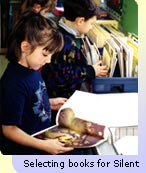Making
the Most of Silent Reading
 Make
time for silent reading every day Make
time for silent reading every day
Silent
Reading is 20 minutes of quiet time spent one on one with self-selected
books. Also known as D.E.A.R. Time in many classrooms, my
students drop everything and read
immediately following lunch as a way of regrouping for the afternoon
ahead, of seeing reading skills used by authors in the pages of
books, and most importantly, as a way of enjoying a book chosen
all by themselves. Although the only items you really need for silent
reading are children, books, and quiet time, here are a few helpful
hints to make the most of this one-on-one time with books:
|
|
 |
| |
Tips
for a Successful Silent Reading Time
Before
Silent Reading:
- Have
students select two to three books that will "keep
them
happy" for the entire silent reading period so
that time is spent reading, not going back and forth
to the classroom library.
- The
teacher should take a quick glance at books selected
in order to help students reselect books at a
more appropriate level if necessary.
During
Silent Reading:
- The
teacher reads, too! To model good silent reading practices
and to demonstrate an interest in books and a love
of literature, spend the first five minutes looking at books,
too.
- Encourage
those students who struggle with reading or
are prereaders to picture-read the story and connect words
from the text to the pictures.
- Remind
those readers who say, "I've read all the books in
the room" that favorite books can be enjoyed again
and
again to make new discoveries on every page.
After
Silent Reading:
- Permit
students to keep one book from the classroom library
in their desk that they have not yet finished.
- Remind
students to return books they have finished to
the classroom library so that it remains as well stocked
as possible.
- A few
times a week make time for students to recommend books
from the classroom library to classmates.
|
|
 |
 |
 |
 |
 |
 |
 |
 |
In the five minutes before lunch, I take a quick stroll around
the room commenting on students' silent reading selections of
the day. Not only am I ensuring that they have made appropriate
choices according to abilities, but I let students know I am
interested in the books they choose to read. |
 |
 |
 |
 |
 |
| |
When
Stocking a Classroom Library, Be Sure to Include:
- Books
from a range of reading levels
- Picture
books
- Rhyming
word books
- Books
of all genres
- Magazines
such as Sports Illustrated for Kids and Ranger
Rick
- Extra
copies of favorite books
- Classics,
Caldecott and Newbery winners
- Collections
of student-published stories
|
|
 |
|
  |
|